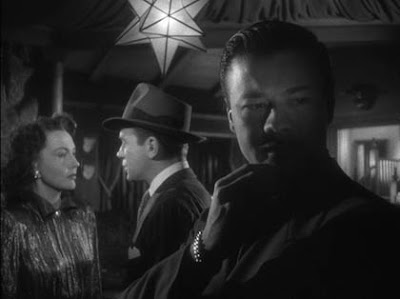Starring: Matt Willis, Frieda Inescort, Nina Foch and Bela Lugosi
Director: Lew Landers
Rating: Four of Ten Stars
At the height of WWI, Lady Jane (Inescort) joined with an occult expert to slay a vampire (Lugosi) that was preying on his daughter. More than two decades later, as WWII rages, the vampire is restored to life during Nazi bombing raid on London. He sets about executing revenge and to claim the victim he was once denied (Foch).

According to some sources, "Return of the Vampire" started as Columbia's plan to make a direct sequel to Universal's classic "Dracula"... until Universal threatened to sue. In response, Columbia then had some minor script changes done, including changing all the names of the characters, but otherwise proceeded with their project as planned. Although he was called "Armand Tesla," Bela Lugosi was once again playing the role that made him a movie star.
Unfortunately, "Return of the Vampire" isn't as good as "Dracula." The story is weaker here, not to mention even more predictable even than one based on a famous stage play and novel, and the sets and camera-work aren't even close to as evocative as those featured in Lugosi's previous outing as a vampire. Even the film where he played a fake vampire ("Mark of the Vampire") had more horror atmosphere and surprises than this film, which has a slap-dash, quickie feel to it from beginning to end. (A minor source of distraction while watching is that also seems obvious that many of the scenes featuring "Bela Lugosi" are actually a body double. It's slightly less obvious than the doubling Edward D. Wood Jr would do a decade later when Lugosi passed away during production of "Plan 9 From Outer Space," but it's still plain.)
Despite mostly tepid direction, an almost entirely predictable script, and one of the most drab collections of vampire film characters since the original "Dracula" film, there are some highlights here that makes it interesting to watch.
Firstly, the film is the first to feature both a vampire and a werewolf, beating "House of Frankenstein" to the screens by a matter of months.
Secondly, the film draws upon a more truthfully folklore oriented background for its featured werewolf than the made-up-of-whole-cloth lycanthrope legend from "The Wolf Man" which has become the pop cultural standard. In the universe of "Return of the Vampire," a werewolf is a person dominated and controlled by evil forces and the cycles of the moon have nothing to do with anything except the tides.
Thirdly, it is one of the few monster movies of this vintage that places itself firmly in the everyday world, with its references to the German bombings on London and the overall war effort. I think only Val Lewton's films for RKO were more successful in highlighting supernatural horror by placing it squarely in the middle of the recognizable modern world. (This approach would, of course, swiftly become the norm.)
Finally, while the film's director and cinematographer both mostly seem to have been on vacation while this film was being made, they did manage to create some classic fright moments on the film's cemetery set--the vampire moving through the fogbound graveyard are the films most visually interesting moments--and the final confrontation in the tomb actually manages to bring some real excitement and tension to the film. It's the one point while watching it where I found myself unsure of how the scene would play out, and after roughly an hour of lameness, the film finally became worthwhile and ended on a strong note.
"Return of the Vampire" is really only of interest for those Lugosi completists out there, or if you are the world's biggest admirer of Nina Foch. There is is really not enough entertainment here for the average fan of old movies to make it worth seeking out.






















%20by%20George%20Mann.jpg)






.jpg)
